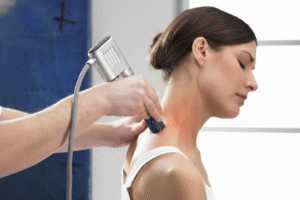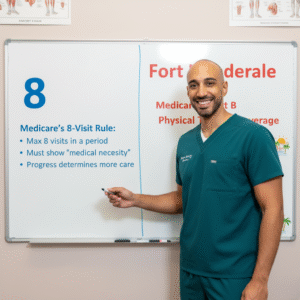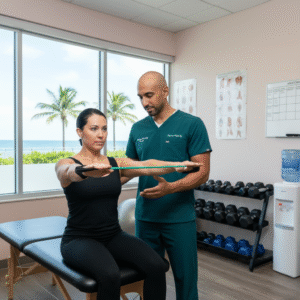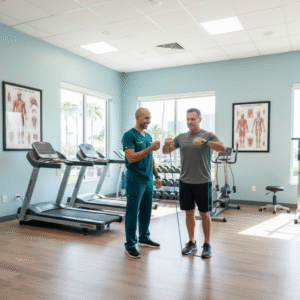Regaining Strength and Motion After Elbow Surgery
Recovering from elbow surgery can be a slow process, but with the right rehabilitation plan, you can restore mobility, reduce stiffness, and regain strength safely and efficiently. Whether you’ve had an elbow fracture, ligament repair, or arthroscopy, a structured post-operative exercise routine plays a vital role in full recovery.
This guide will walk you through the most effective post-surgery elbow rehabilitation exercises you can perform, either at home or under professional supervision.
Why Elbow Rehab Matters After Surgery
Following elbow surgery, it’s normal to experience stiffness, swelling, and reduced movement. Without proper rehabilitation, your joint may become permanently limited in motion or weakened in strength.
Goals of elbow rehab:
- Regain range of motion (ROM)
- Improve flexibility and joint function
- Reduce swelling and inflammation
- Prevent muscle atrophy
- Gradually rebuild strength
Starting with gentle movement and progressing toward more active exercises helps ensure you recover safely without risking reinjury.
When to Start Elbow Rehab Exercises
Always follow your surgeon’s specific post-operative timeline, but in general:
- Phase 1 (0–2 weeks post-surgery): Rest, immobilization, and gentle passive motion
- Phase 2 (2–6 weeks): Begin active range of motion (AROM) exercises
- Phase 3 (6–12 weeks): Add strengthening and functional movements
- Phase 4 (3 months+): Return to sports or full physical activity
Let’s break down the best exercises for each phase.
Phase 1: Gentle Movement & Mobility (0–2 Weeks)
Your focus should be on reducing swelling and preserving basic movement without straining the surgical site.
1. Wrist and Hand Pumps
Move your wrist and open/close your hand repeatedly to stimulate circulation.
2 sets of 10–15 repetitions, several times per day
2. Passive Elbow Flexion/Extension
Use your opposite hand to gently bend and straighten your elbow while keeping pain below a 3/10 level.
5–10 reps, 3–5 times daily
Phase 2: Active Range of Motion (2–6 Weeks)
You’ll start using your muscles to move the joint, gradually increasing the range of motion.
3. Elbow Flexion and Extension (Active)
Without assistance, slowly bend and straighten your elbow.
2–3 sets of 10 repetitions, 2 times daily
4. Forearm Supination and Pronation
With your elbow bent at 90°, slowly rotate your forearm palm-up and palm-down.
3 sets of 10 reps, 2–3 times a day
5. Shoulder Rolls and Shrugs
Gentle shoulder movement helps avoid upper body stiffness.
10 repetitions, 2–3 sets per day
Phase 3: Strengthening and Control (6–12 Weeks)
As healing progresses, you can begin light resistance work to rebuild arm strength.
6. Isometric Biceps Contraction
Hold your arm at 90°, press your palm against a wall without moving your elbow.
Hold for 5–10 seconds, repeat 10 times
7. TheraBand Bicep Curls
Using a resistance band, perform slow bicep curls.
2–3 sets of 10–12 reps
8. Forearm Grip Squeezes
Use a stress ball or therapy putty to improve grip strength.
3 sets of 10 reps, several times weekly
9. Overhead Reach
Stretch arms overhead gently to improve full-arm mobility.
2 sets of 10 reps
Phase 4: Functional Recovery (3 Months and Beyond)
Focus on returning to daily activities, sports, or work duties with full mobility and coordination.
10. Push-Ups on Wall or Counter
Helps improve tricep and shoulder strength while protecting the elbow.
Start with wall push-ups, then progress to counter-height, 3 sets of 10
11. Light Dumbbell Presses
Use 1–3 lb weights to mimic lifting objects.
3 sets of 10 reps, 2–3 times per week
Important Rehab Tips to Remember
- Always warm up before exercise to increase circulation
- Use ice after exercise to reduce inflammation
- Avoid pushing through sharp pain; discomfort is okay, but pain is not
- Stay consistent: Gentle daily movements lead to long-term progress
- Track your ROM (range of motion) to measure progress
And most importantly, stay in close contact with your orthopedic surgeon or physical therapist to monitor your recovery and adjust your routine as needed.
When to Seek Professional Help
If you experience any of the following, consult your doctor immediately:
- Persistent swelling or redness
- Sudden loss of motion
- Sharp or worsening pain
- Numbness or tingling in the fingers
- Difficulty performing basic daily tasks
Professional rehabilitation may be required if recovery is not progressing as expected.
Final Thoughts
Post-surgery elbow rehabilitation is a journey that requires time, patience, and the right exercises. By following a structured program tailored to your recovery stage, you can rebuild your strength, restore full mobility, and return to the activities you love.
Whether you’re recovering from a fracture, tendon repair, or elbow replacement, your dedication to rehab will make all the difference.
Need expert guidance for your elbow rehab? Contact a licensed physiotherapist or schedule a personalized recovery plan tailored to your post-op needs.






